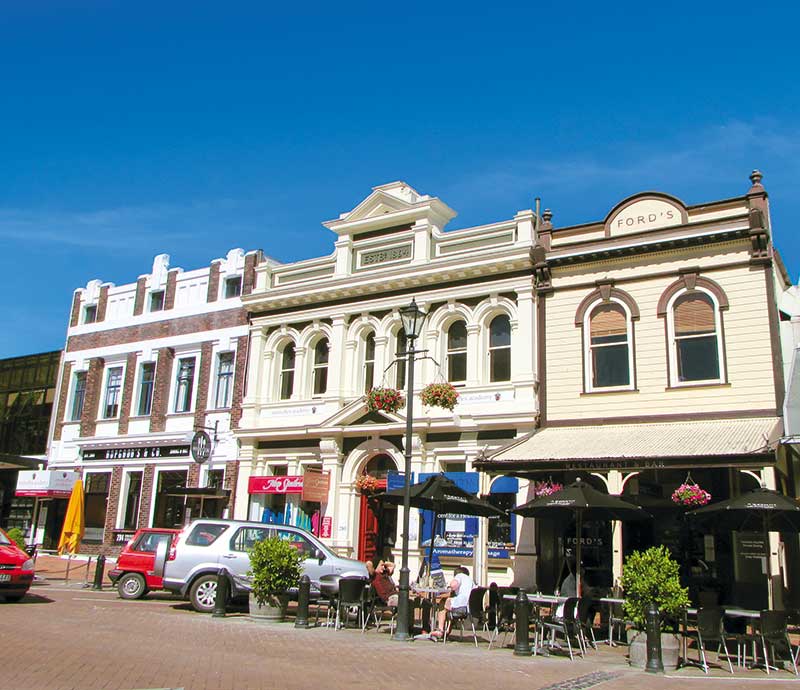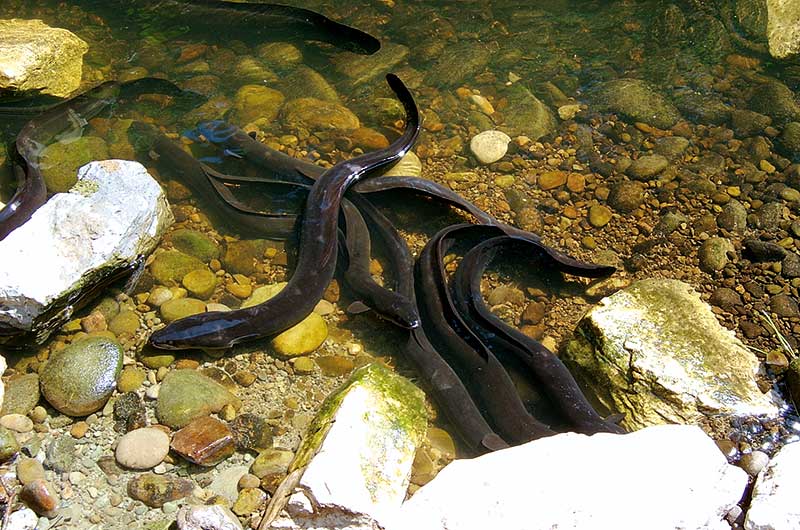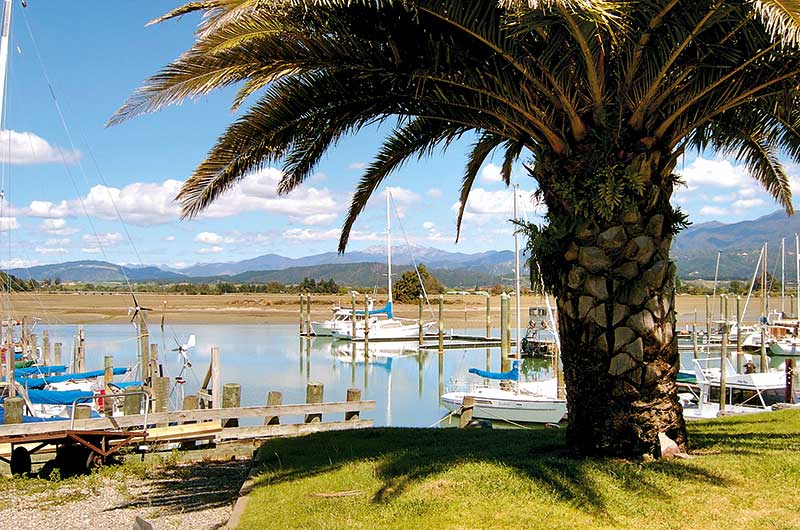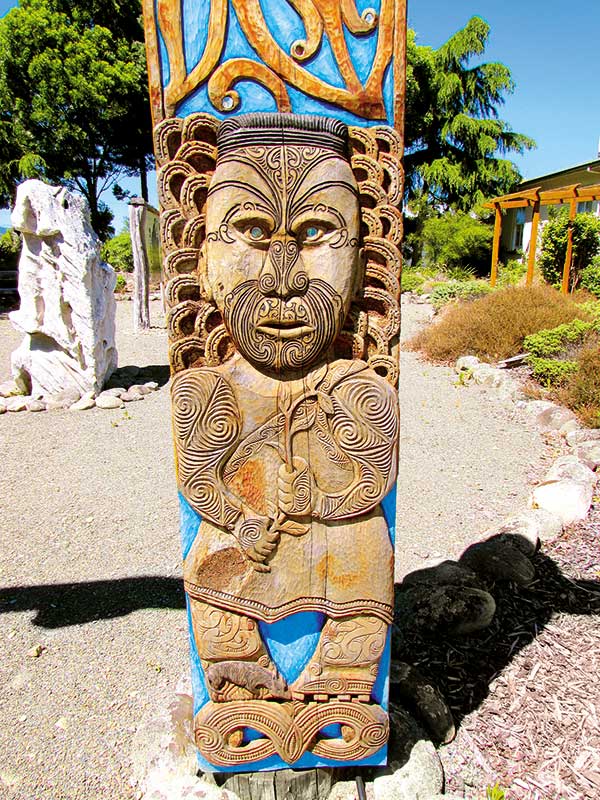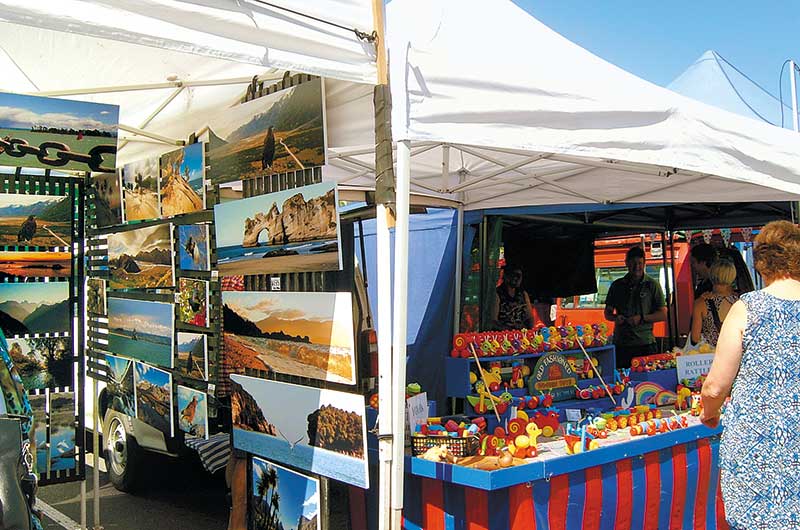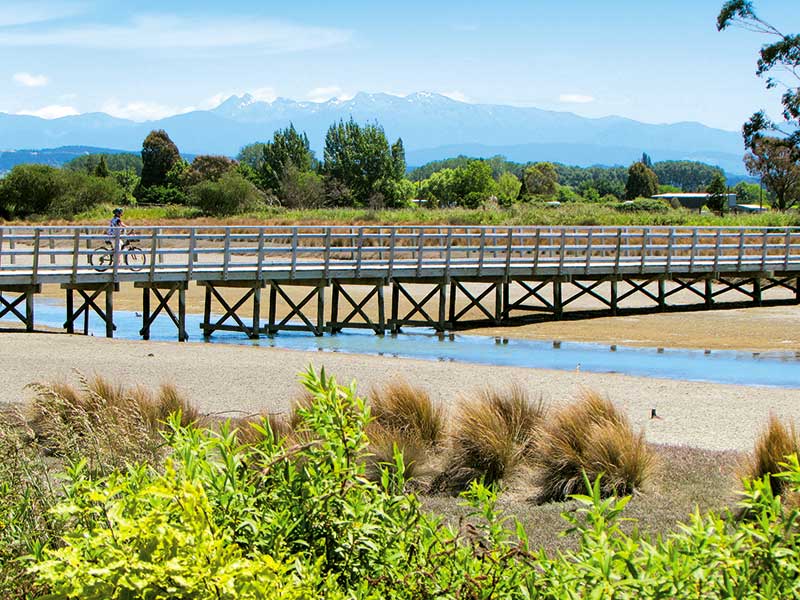As cycle trail names go, this one had a lot of appeal. We were at a great Park Over Property (POP)—an olde-English-style pub called the Honest Lawyer—right on the trail, so how could we not dust the bikes off?
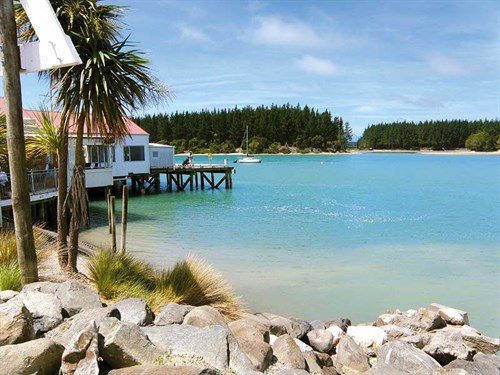 There are three routes on the Great Taste Trail: the Rail Route, the Valley Route, and the Coastal Route—the one we rode.
This easy, flat ride follows the Tasman Bay coast around the Waimea Inlet to Rabbit Island, across by ferry to Mapua and up the coast to Motueka before finishing at Kaiteriteri.
Of course, we rode the trail in stages, sampling food and drinks as we passed through townships, vineyards, orchards, olive groves, and hop-growing areas.
The waters of the peaceful Waimea Inlet sparkled as we cycled along the boardwalks and cycle tracks that border the estuary.
A wide range of seabirds can be seen here, including royal spoonbills, white herons, godwits, egrets, and banded rail. We were impressed by the bridges especially constructed for the trail.
Mapua Wharf, once one of the country’s largest collection points for the apple harvest, is now a quiet and pretty spot to while away some time over a coffee or a meal. There are several cafes with views across the water to Rabbit Island.
The Nelson area is renowned for its artists and there are galleries aplenty at Mapua and along the cycle trail, too.
From Mapua, we meandered along the Ruby Bay coast, past seaside settlements and on to Tasman where the quirky Jester House Cafe has a garden setting and tame eels in a stream.We recommend the gourmet pies at the Store and Coffee Roastery here.
On a quiet road between Lower Motuere and the Moutere Inlet, we came across another offbeat eatery, the Riverside Cafe.
This is part of the Riverside Community, New Zealand’s oldest ‘intentional community’, founded in 1941, pre-dating hippy communes and is still flourishing. Interestingly, the community sells fresh, unpasteurised milk from a vending machine (BYO bottle) at the roadside.
There is plenty to do at Motueka: it is a good service town with a laundrette, supermarket, and a wide variety of shops. There is also a Sunday market, with food and craft stalls, which is worth checking out.
We stayed at the freedom camping area (it has a donation box) at the end of wharf road. You’ll spot some unusual saltwater baths here that were built in 1938, as the beach was considered unsafe for bathing because there were sharks in the bay.
The cycle trail at Motueka takes riders through pretty coastal scenery and an inland area of orchards before reaching the coast again at the spot where Arthur Wakefield stepped ashore in 1841.
The last three kilometres of the Great Taste Trail passes through a mountain bike park, which is fun for those who like the adrenaline rush.
Kaiteriteri is a beautiful spot but somewhat a victim of its own popularity. A little further around the coast is Split Apple Bay Beach, which is less visited and a great place for a quiet picnic.
There are three routes on the Great Taste Trail: the Rail Route, the Valley Route, and the Coastal Route—the one we rode.
This easy, flat ride follows the Tasman Bay coast around the Waimea Inlet to Rabbit Island, across by ferry to Mapua and up the coast to Motueka before finishing at Kaiteriteri.
Of course, we rode the trail in stages, sampling food and drinks as we passed through townships, vineyards, orchards, olive groves, and hop-growing areas.
The waters of the peaceful Waimea Inlet sparkled as we cycled along the boardwalks and cycle tracks that border the estuary.
A wide range of seabirds can be seen here, including royal spoonbills, white herons, godwits, egrets, and banded rail. We were impressed by the bridges especially constructed for the trail.
Mapua Wharf, once one of the country’s largest collection points for the apple harvest, is now a quiet and pretty spot to while away some time over a coffee or a meal. There are several cafes with views across the water to Rabbit Island.
The Nelson area is renowned for its artists and there are galleries aplenty at Mapua and along the cycle trail, too.
From Mapua, we meandered along the Ruby Bay coast, past seaside settlements and on to Tasman where the quirky Jester House Cafe has a garden setting and tame eels in a stream.We recommend the gourmet pies at the Store and Coffee Roastery here.
On a quiet road between Lower Motuere and the Moutere Inlet, we came across another offbeat eatery, the Riverside Cafe.
This is part of the Riverside Community, New Zealand’s oldest ‘intentional community’, founded in 1941, pre-dating hippy communes and is still flourishing. Interestingly, the community sells fresh, unpasteurised milk from a vending machine (BYO bottle) at the roadside.
There is plenty to do at Motueka: it is a good service town with a laundrette, supermarket, and a wide variety of shops. There is also a Sunday market, with food and craft stalls, which is worth checking out.
We stayed at the freedom camping area (it has a donation box) at the end of wharf road. You’ll spot some unusual saltwater baths here that were built in 1938, as the beach was considered unsafe for bathing because there were sharks in the bay.
The cycle trail at Motueka takes riders through pretty coastal scenery and an inland area of orchards before reaching the coast again at the spot where Arthur Wakefield stepped ashore in 1841.
The last three kilometres of the Great Taste Trail passes through a mountain bike park, which is fun for those who like the adrenaline rush.
Kaiteriteri is a beautiful spot but somewhat a victim of its own popularity. A little further around the coast is Split Apple Bay Beach, which is less visited and a great place for a quiet picnic.
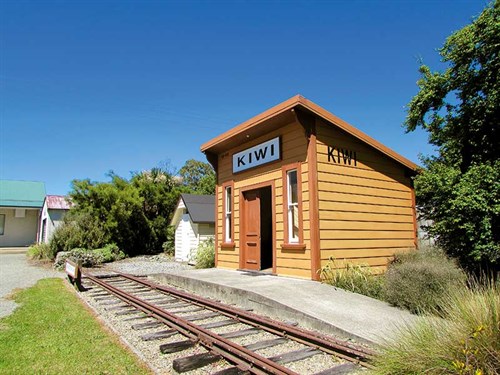 After several days of cycling, we decided to further explore of the area by car. Names such as Brooklyn, Orinoco, and Woodstock were intriguing, so we moved the bus to a freedom camping spot at Norris Gully near Spooners Saddle and set out to explore the fertile valleys inland.
In the peaceful Motueka Valley, we came to Tapawera. This little settlement had pretty gardens with an interesting Maori gateway celebrating the explorer and surveyor Thomas Brunner and his Maori guide, E Kehu.
In 1842, the pair surveyed the Motueka hinterlands and later other areas. What caught our attention most here was an old railway station called Kiwi. This turned out to be the township’s museum where we learned the story of the area and the history of the railway, in particular.
I hadn’t known that in 1954 a group of elderly and middle-aged women had made headlines internationally when they staged a sit-in, protesting the closure of the line from Nelson.
Rumours of communists and saboteurs led the security police to swoop on the group, who they found to be sitting quietly on the railway lines, knitting and chatting.
Unfortunately, the protest was unsuccessful and the railway was ripped up. We drove along the road past the former stations and halts of Kiwi, Tui, Kaka, and Huia but there is little evidence now of a railway line.
Closer to the coast on the Moutere Highway, we found the settlement of Upper Moutere, home to New Zealand’s oldest pub. Others may have gained licences earlier but the Moutere Inn, built in 1850, is still operating from the same building.
Further on, the early settlement of Wakefield is named after Arthur Wakefield whose name we had seen on the roadside plaque near Kaiteriteri. Many of the town’s old buildings remain, making it an interesting place to spend some time wandering around.
Back in Nelson, we spent a few days enjoying everything the city has to offer. There are shops, galleries, museums (including the World of Wearable Art and Classic Cars Museum where NZMCA members can park overnight), and Nelson’s markets to experience.
The beaches have kayaking and paddle boarding options, and the hills have mountain biking and bush walk tracks.
And for those of us who had got hooked on the local food and drink, there are many restaurants showcasing the seafood, wine, and fresh produce the area is famous for.
After several days of cycling, we decided to further explore of the area by car. Names such as Brooklyn, Orinoco, and Woodstock were intriguing, so we moved the bus to a freedom camping spot at Norris Gully near Spooners Saddle and set out to explore the fertile valleys inland.
In the peaceful Motueka Valley, we came to Tapawera. This little settlement had pretty gardens with an interesting Maori gateway celebrating the explorer and surveyor Thomas Brunner and his Maori guide, E Kehu.
In 1842, the pair surveyed the Motueka hinterlands and later other areas. What caught our attention most here was an old railway station called Kiwi. This turned out to be the township’s museum where we learned the story of the area and the history of the railway, in particular.
I hadn’t known that in 1954 a group of elderly and middle-aged women had made headlines internationally when they staged a sit-in, protesting the closure of the line from Nelson.
Rumours of communists and saboteurs led the security police to swoop on the group, who they found to be sitting quietly on the railway lines, knitting and chatting.
Unfortunately, the protest was unsuccessful and the railway was ripped up. We drove along the road past the former stations and halts of Kiwi, Tui, Kaka, and Huia but there is little evidence now of a railway line.
Closer to the coast on the Moutere Highway, we found the settlement of Upper Moutere, home to New Zealand’s oldest pub. Others may have gained licences earlier but the Moutere Inn, built in 1850, is still operating from the same building.
Further on, the early settlement of Wakefield is named after Arthur Wakefield whose name we had seen on the roadside plaque near Kaiteriteri. Many of the town’s old buildings remain, making it an interesting place to spend some time wandering around.
Back in Nelson, we spent a few days enjoying everything the city has to offer. There are shops, galleries, museums (including the World of Wearable Art and Classic Cars Museum where NZMCA members can park overnight), and Nelson’s markets to experience.
The beaches have kayaking and paddle boarding options, and the hills have mountain biking and bush walk tracks.
And for those of us who had got hooked on the local food and drink, there are many restaurants showcasing the seafood, wine, and fresh produce the area is famous for.
Cycling Tasman's Great Taste Trail
 There are three routes on the Great Taste Trail: the Rail Route, the Valley Route, and the Coastal Route—the one we rode.
This easy, flat ride follows the Tasman Bay coast around the Waimea Inlet to Rabbit Island, across by ferry to Mapua and up the coast to Motueka before finishing at Kaiteriteri.
Of course, we rode the trail in stages, sampling food and drinks as we passed through townships, vineyards, orchards, olive groves, and hop-growing areas.
The waters of the peaceful Waimea Inlet sparkled as we cycled along the boardwalks and cycle tracks that border the estuary.
A wide range of seabirds can be seen here, including royal spoonbills, white herons, godwits, egrets, and banded rail. We were impressed by the bridges especially constructed for the trail.
Mapua Wharf, once one of the country’s largest collection points for the apple harvest, is now a quiet and pretty spot to while away some time over a coffee or a meal. There are several cafes with views across the water to Rabbit Island.
The Nelson area is renowned for its artists and there are galleries aplenty at Mapua and along the cycle trail, too.
From Mapua, we meandered along the Ruby Bay coast, past seaside settlements and on to Tasman where the quirky Jester House Cafe has a garden setting and tame eels in a stream.We recommend the gourmet pies at the Store and Coffee Roastery here.
On a quiet road between Lower Motuere and the Moutere Inlet, we came across another offbeat eatery, the Riverside Cafe.
This is part of the Riverside Community, New Zealand’s oldest ‘intentional community’, founded in 1941, pre-dating hippy communes and is still flourishing. Interestingly, the community sells fresh, unpasteurised milk from a vending machine (BYO bottle) at the roadside.
There is plenty to do at Motueka: it is a good service town with a laundrette, supermarket, and a wide variety of shops. There is also a Sunday market, with food and craft stalls, which is worth checking out.
We stayed at the freedom camping area (it has a donation box) at the end of wharf road. You’ll spot some unusual saltwater baths here that were built in 1938, as the beach was considered unsafe for bathing because there were sharks in the bay.
The cycle trail at Motueka takes riders through pretty coastal scenery and an inland area of orchards before reaching the coast again at the spot where Arthur Wakefield stepped ashore in 1841.
The last three kilometres of the Great Taste Trail passes through a mountain bike park, which is fun for those who like the adrenaline rush.
Kaiteriteri is a beautiful spot but somewhat a victim of its own popularity. A little further around the coast is Split Apple Bay Beach, which is less visited and a great place for a quiet picnic.
There are three routes on the Great Taste Trail: the Rail Route, the Valley Route, and the Coastal Route—the one we rode.
This easy, flat ride follows the Tasman Bay coast around the Waimea Inlet to Rabbit Island, across by ferry to Mapua and up the coast to Motueka before finishing at Kaiteriteri.
Of course, we rode the trail in stages, sampling food and drinks as we passed through townships, vineyards, orchards, olive groves, and hop-growing areas.
The waters of the peaceful Waimea Inlet sparkled as we cycled along the boardwalks and cycle tracks that border the estuary.
A wide range of seabirds can be seen here, including royal spoonbills, white herons, godwits, egrets, and banded rail. We were impressed by the bridges especially constructed for the trail.
Mapua Wharf, once one of the country’s largest collection points for the apple harvest, is now a quiet and pretty spot to while away some time over a coffee or a meal. There are several cafes with views across the water to Rabbit Island.
The Nelson area is renowned for its artists and there are galleries aplenty at Mapua and along the cycle trail, too.
From Mapua, we meandered along the Ruby Bay coast, past seaside settlements and on to Tasman where the quirky Jester House Cafe has a garden setting and tame eels in a stream.We recommend the gourmet pies at the Store and Coffee Roastery here.
On a quiet road between Lower Motuere and the Moutere Inlet, we came across another offbeat eatery, the Riverside Cafe.
This is part of the Riverside Community, New Zealand’s oldest ‘intentional community’, founded in 1941, pre-dating hippy communes and is still flourishing. Interestingly, the community sells fresh, unpasteurised milk from a vending machine (BYO bottle) at the roadside.
There is plenty to do at Motueka: it is a good service town with a laundrette, supermarket, and a wide variety of shops. There is also a Sunday market, with food and craft stalls, which is worth checking out.
We stayed at the freedom camping area (it has a donation box) at the end of wharf road. You’ll spot some unusual saltwater baths here that were built in 1938, as the beach was considered unsafe for bathing because there were sharks in the bay.
The cycle trail at Motueka takes riders through pretty coastal scenery and an inland area of orchards before reaching the coast again at the spot where Arthur Wakefield stepped ashore in 1841.
The last three kilometres of the Great Taste Trail passes through a mountain bike park, which is fun for those who like the adrenaline rush.
Kaiteriteri is a beautiful spot but somewhat a victim of its own popularity. A little further around the coast is Split Apple Bay Beach, which is less visited and a great place for a quiet picnic.
Exploring Nelson by car
 After several days of cycling, we decided to further explore of the area by car. Names such as Brooklyn, Orinoco, and Woodstock were intriguing, so we moved the bus to a freedom camping spot at Norris Gully near Spooners Saddle and set out to explore the fertile valleys inland.
In the peaceful Motueka Valley, we came to Tapawera. This little settlement had pretty gardens with an interesting Maori gateway celebrating the explorer and surveyor Thomas Brunner and his Maori guide, E Kehu.
In 1842, the pair surveyed the Motueka hinterlands and later other areas. What caught our attention most here was an old railway station called Kiwi. This turned out to be the township’s museum where we learned the story of the area and the history of the railway, in particular.
I hadn’t known that in 1954 a group of elderly and middle-aged women had made headlines internationally when they staged a sit-in, protesting the closure of the line from Nelson.
Rumours of communists and saboteurs led the security police to swoop on the group, who they found to be sitting quietly on the railway lines, knitting and chatting.
Unfortunately, the protest was unsuccessful and the railway was ripped up. We drove along the road past the former stations and halts of Kiwi, Tui, Kaka, and Huia but there is little evidence now of a railway line.
Closer to the coast on the Moutere Highway, we found the settlement of Upper Moutere, home to New Zealand’s oldest pub. Others may have gained licences earlier but the Moutere Inn, built in 1850, is still operating from the same building.
Further on, the early settlement of Wakefield is named after Arthur Wakefield whose name we had seen on the roadside plaque near Kaiteriteri. Many of the town’s old buildings remain, making it an interesting place to spend some time wandering around.
Back in Nelson, we spent a few days enjoying everything the city has to offer. There are shops, galleries, museums (including the World of Wearable Art and Classic Cars Museum where NZMCA members can park overnight), and Nelson’s markets to experience.
The beaches have kayaking and paddle boarding options, and the hills have mountain biking and bush walk tracks.
And for those of us who had got hooked on the local food and drink, there are many restaurants showcasing the seafood, wine, and fresh produce the area is famous for.
After several days of cycling, we decided to further explore of the area by car. Names such as Brooklyn, Orinoco, and Woodstock were intriguing, so we moved the bus to a freedom camping spot at Norris Gully near Spooners Saddle and set out to explore the fertile valleys inland.
In the peaceful Motueka Valley, we came to Tapawera. This little settlement had pretty gardens with an interesting Maori gateway celebrating the explorer and surveyor Thomas Brunner and his Maori guide, E Kehu.
In 1842, the pair surveyed the Motueka hinterlands and later other areas. What caught our attention most here was an old railway station called Kiwi. This turned out to be the township’s museum where we learned the story of the area and the history of the railway, in particular.
I hadn’t known that in 1954 a group of elderly and middle-aged women had made headlines internationally when they staged a sit-in, protesting the closure of the line from Nelson.
Rumours of communists and saboteurs led the security police to swoop on the group, who they found to be sitting quietly on the railway lines, knitting and chatting.
Unfortunately, the protest was unsuccessful and the railway was ripped up. We drove along the road past the former stations and halts of Kiwi, Tui, Kaka, and Huia but there is little evidence now of a railway line.
Closer to the coast on the Moutere Highway, we found the settlement of Upper Moutere, home to New Zealand’s oldest pub. Others may have gained licences earlier but the Moutere Inn, built in 1850, is still operating from the same building.
Further on, the early settlement of Wakefield is named after Arthur Wakefield whose name we had seen on the roadside plaque near Kaiteriteri. Many of the town’s old buildings remain, making it an interesting place to spend some time wandering around.
Back in Nelson, we spent a few days enjoying everything the city has to offer. There are shops, galleries, museums (including the World of Wearable Art and Classic Cars Museum where NZMCA members can park overnight), and Nelson’s markets to experience.
The beaches have kayaking and paddle boarding options, and the hills have mountain biking and bush walk tracks.
And for those of us who had got hooked on the local food and drink, there are many restaurants showcasing the seafood, wine, and fresh produce the area is famous for.
More information
- Brochures with information about places and activities in the Nelson region can be obtained at the i-Sites in Nelson and Motueka. The Nelson i-Site is on the corner of Trafalgar and Halifax streets and the Motueka i-Site is at 20 Wallace Street.
- Look out for roadside fruit stalls or buy fresh produce from Nelson’s Saturday market or the Wednesday farmers market.



